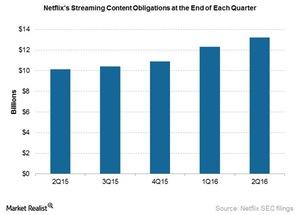How Does Netflix View Its Streaming Content Obligations?
Streaming content obligations are the costs that Netflix pays for the licensing, acquiring, and producing content.
July 27 2016, Updated 11:05 a.m. ET

Rise in streaming content obligation
Streaming content obligations are the costs that Netflix pays for the licensing, acquiring, and producing content. Netflix (NFLX) had streaming content obligations of $13.2 billion at the end of fiscal 2Q16, a rise of 31% year-over-year, as the chart below shows.
Netflix stated on its fiscal 2Q16 earnings call that the steep rise in content spending was justified since Netflix’s investment in content isn’t only for the current quarter but for the next several years. The company also said that a factor driving increased content spending was its international expansion.
The company explained this statement further by claiming that there was a rise in content spending at some of its newer territories compared to international markets where it was already an established brand. The company also reiterated that its content spending this quarter was in line with its earlier launches in new international territories.
Netflix also stated, “We’re very confident of that and our competitive position is very strong so those are the two fundamental things that give us confidence in the long term and want to us to continue to invest in more content.”
How much does Netflix spend on global content licensing rights?
Netflix explained that its content licensing deals follow a “media market share models” model. As such, the company has not “broken out an exact percentage” of its content spend on global content licensing deals. The company also stated that it also has the global content licensing deals for content libraries of different media companies which have a niche, global audience.
